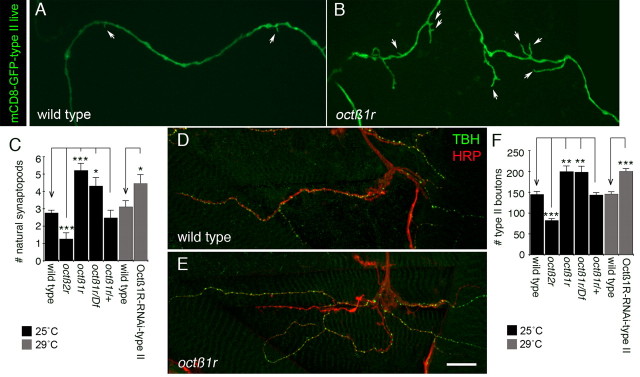Figure 2.
octß1r mutants display an overgrowth of octopaminergic endings at the NMJ. A, B, Confocal Z-stack projections of type II arbors at muscle 12 in larvae expressing mCD8-GFP in octopaminergic neurons of control (A) and octß1r mutant (B), showing a marked increase in the number of natural synaptopods (white arrows). C, Quantification of the number of natural synaptopods per 100 μm of type II arbor in octß2r mutants, octß1r mutants, and animals expressing Octß1R-RNAi in type II motorneurons, showing increased natural synaptopods in octß1r mutants and Octß1R-RNAi animals [N (left to right) = 175, 13, 21, 10, 11, 25, 17 NMJs]. D, E, Third-instar larval NMJs at muscles 12 of wild-type (D) and octß1r mutant (E), showing a marked increase in the number of type II boutons (shown by TBH labeling). NMJs were double labeled with anti-TBH (green) and anti-HRP (red). The panels represent confocal Z-stack projections. F, Quantification of the number of type II boutons at muscle 12 in octß2r mutants, octß1r mutants, and animals expressing Octß1R-RNAi in type II motorneurons, showing increased type II boutons in octß1r mutants and Octß1R-RNAi animals [N (left to right) = 22, 17, 15, 11, 16, 20, 11 NMJs]. Animals used in RNAi experiments were reared at 29°C to increase knockdown efficiency. Scale bar: A, B, 8 μm; D, E, 20 μm. Error bars indicate SEM. ***p < = 0.0001; **p < = 0.001; *p < 0.05.

